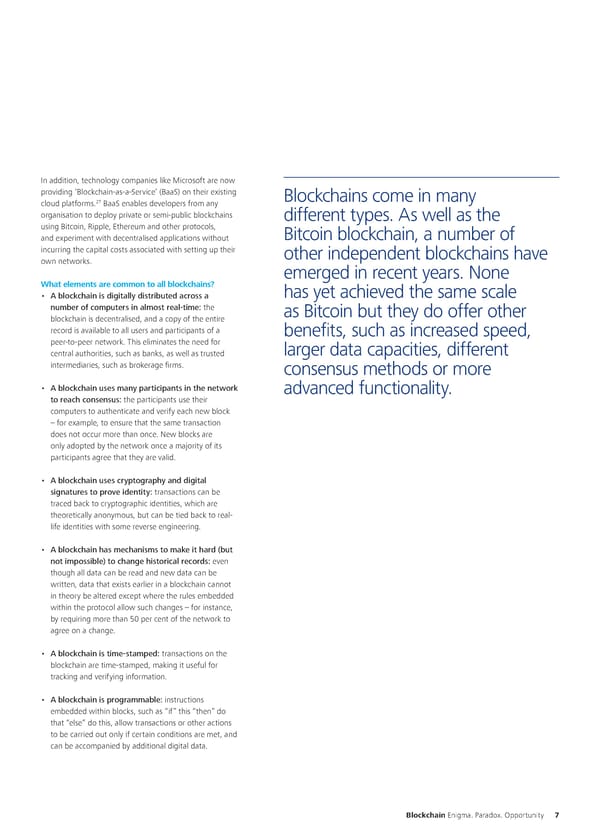To start a new section, hold down the apple+shift keys and click to release this object and type the section title in the box below. In addition, technology companies like Microsoft are now providing ‘Blockchain-as-a-Service’ (BaaS) on their existing Blockchains come in many cloud platforms.27 BaaS enables developers from any organisation to deploy private or semi-public blockchains different types. As well as the using Bitcoin, Ripple, Ethereum and other protocols, Bitcoin blockchain, a number of and experiment with decentralised applications without incurring the capital costs associated with setting up their other independent blockchains have own networks. emerged in recent years. None What elements are common to all blockchains? has yet achieved the same scale • A blockchain is digitally distributed across a number of computers in almost real-time: the as Bitcoin but they do offer other blockchain is decentralised, and a copy of the entire record is available to all users and participants of a benefits, such as increased speed, peer-to-peer network. This eliminates the need for larger data capacities, different central authorities, such as banks, as well as trusted intermediaries, such as brokerage firms. consensus methods or more • A blockchain uses many participants in the network advanced functionality. to reach consensus: the participants use their computers to authenticate and verify each new block – for example, to ensure that the same transaction does not occur more than once. New blocks are only adopted by the network once a majority of its participants agree that they are valid. • A blockchain uses cryptography and digital signatures to prove identity: transactions can be traced back to cryptographic identities, which are theoretically anonymous, but can be tied back to real- life identities with some reverse engineering. • A blockchain has mechanisms to make it hard (but not impossible) to change historical records: even though all data can be read and new data can be written, data that exists earlier in a blockchain cannot in theory be altered except where the rules embedded within the protocol allow such changes – for instance, by requiring more than 50 per cent of the network to agree on a change. • A blockchain is time-stamped: transactions on the blockchain are time-stamped, making it useful for tracking and verifying information. • A blockchain is programmable: instructions embedded within blocks, such as “if” this “then” do that “else” do this, allow transactions or other actions to be carried out only if certain conditions are met, and can be accompanied by additional digital data. Blockchain Enigma. Paradox. Opportunity 7
 Blockchains: Enigma. Paradox. Opportunity. Page 8 Page 10
Blockchains: Enigma. Paradox. Opportunity. Page 8 Page 10